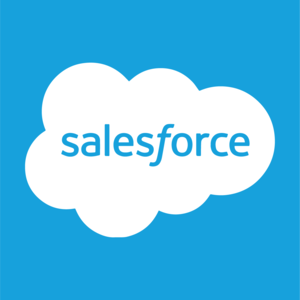
Freshworks (FRSH)
Freshworks is a sound business. Its outstanding sales growth and unit economics give us a line of sight to robust future profits.― StockStory Analyst Team
1. News
2. Summary
Why Freshworks Is Interesting
Starting as a customer service solution before expanding into a comprehensive software suite, Freshworks (NASDAQ:FRSH) provides AI-powered software-as-a-service solutions that help companies manage customer service, IT support, sales, and marketing functions.
- Superior software functionality and low servicing costs result in a top-tier gross margin of 84.8%
- Powerful free cash flow generation enables it to reinvest its profits or return capital to investors consistently
- On the other hand, its net revenue retention rate of 105% trails the industry benchmark of 110%+ and shows it has a tough time increasing customer spending


Freshworks is solid, but not perfect. If you’ve been itching to buy the stock, the valuation looks fair.
Why Is Now The Time To Buy Freshworks?
High Quality
Investable
Underperform
Why Is Now The Time To Buy Freshworks?
Freshworks is trading at $12.86 per share, or 3.9x forward price-to-sales. This multiple seems like a bargain for the top-line momentum you get.
This could be a good time to invest if you think there are underappreciated aspects of the business.
3. Freshworks (FRSH) Research Report: Q3 CY2025 Update
Business software provider Freshworks (NASDAQ:FRSH) reported Q3 CY2025 results topping the market’s revenue expectations, with sales up 15.3% year on year to $215.1 million. Guidance for next quarter’s revenue was better than expected at $218.5 million at the midpoint, 1% above analysts’ estimates. Its non-GAAP profit of $0.16 per share was 25.5% above analysts’ consensus estimates.
Freshworks (FRSH) Q3 CY2025 Highlights:
- Revenue: $215.1 million vs analyst estimates of $208.8 million (15.3% year-on-year growth, 3% beat)
- Adjusted EPS: $0.16 vs analyst estimates of $0.13 (25.5% beat)
- Adjusted Operating Income: $45.18 million vs analyst estimates of $32.39 million (21% margin, 39.5% beat)
- Revenue Guidance for Q4 CY2025 is $218.5 million at the midpoint, above analyst estimates of $216.4 million
- Management raised its full-year Adjusted EPS guidance to $0.63 at the midpoint, a 10.5% increase
- Operating Margin: -3.5%, up from -20.8% in the same quarter last year
- Free Cash Flow Margin: 26.6%, similar to the previous quarter
- Customers: 24,377 customers paying more than $5,000 annually
- Net Revenue Retention Rate: 105%, down from 106% in the previous quarter
- Billings: $224 million at quarter end, up 14.1% year on year
- Market Capitalization: $3.18 billion
Company Overview
Starting as a customer service solution before expanding into a comprehensive software suite, Freshworks (NASDAQ:FRSH) provides AI-powered software-as-a-service solutions that help companies manage customer service, IT support, sales, and marketing functions.
Freshworks' product ecosystem addresses three core business needs: customer relationship management, IT service management, and sales and marketing automation. Its flagship offerings include Freshdesk for customer service ticketing, Freshservice for IT support, and Freshsales for sales force automation. All products are built on the company's Neo platform, which features Freddy AI, a generative AI engine that provides self-service capabilities, contextual assistance, and actionable insights across all applications.
The company employs a product-led growth strategy with a multi-pronged go-to-market approach. Freshworks offers free trials and subscription plans that range from free to premium tiers, making their solutions accessible to businesses of all sizes—from small startups to large enterprises. This approach removes adoption barriers and accelerates customer acquisition.
A business using Freshworks might deploy Freshdesk to manage customer inquiries across multiple channels, implement Freshservice to streamline their IT department's operations, and utilize Freshsales to track sales opportunities—all while benefiting from the AI-powered automation and insights provided by the Freddy AI engine.
Freshworks monetizes through subscription-based pricing models, with higher tiers offering advanced features and capabilities. The company primarily competes with established enterprise software providers like Salesforce, ServiceNow, and Zendesk, as well as specialized players in each segment and legacy vendors such as Oracle, SAP, and Microsoft.
4. Sales Software
Companies need to be able to interact with and sell to their customers as efficiently as possible. This reality coupled with the ongoing migration of enterprises to the cloud drives demand for cloud-based customer relationship management (CRM) software that integrates data analytics with sales and marketing functions.
Freshworks competes with Salesforce (NYSE:CRM), Zendesk (acquired by private equity), and ServiceNow (NYSE:NOW) in various segments, along with legacy vendors like Oracle (NYSE:ORCL), SAP (NYSE:SAP), and Microsoft (NASDAQ:MSFT). The company also faces competition from specialized providers like HubSpot (NYSE:HUBS) in marketing and Atlassian (NASDAQ:TEAM) in IT service management.
5. Revenue Growth
A company’s long-term sales performance can indicate its overall quality. Any business can have short-term success, but a top-tier one grows for years. Thankfully, Freshworks’s 29% annualized revenue growth over the last five years was impressive. Its growth beat the average software company and shows its offerings resonate with customers, a helpful starting point for our analysis.
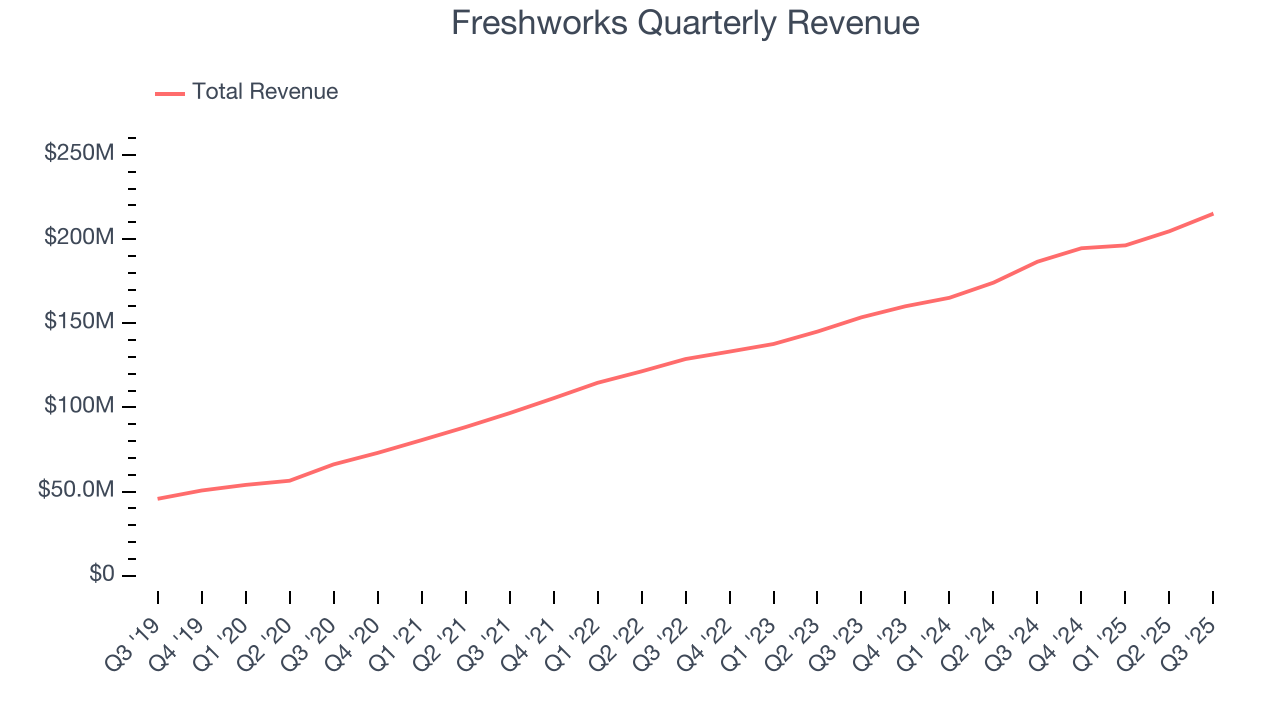
Long-term growth is the most important, but within software, a half-decade historical view may miss new innovations or demand cycles. Freshworks’s annualized revenue growth of 19.3% over the last two years is below its five-year trend, but we still think the results suggest healthy demand. 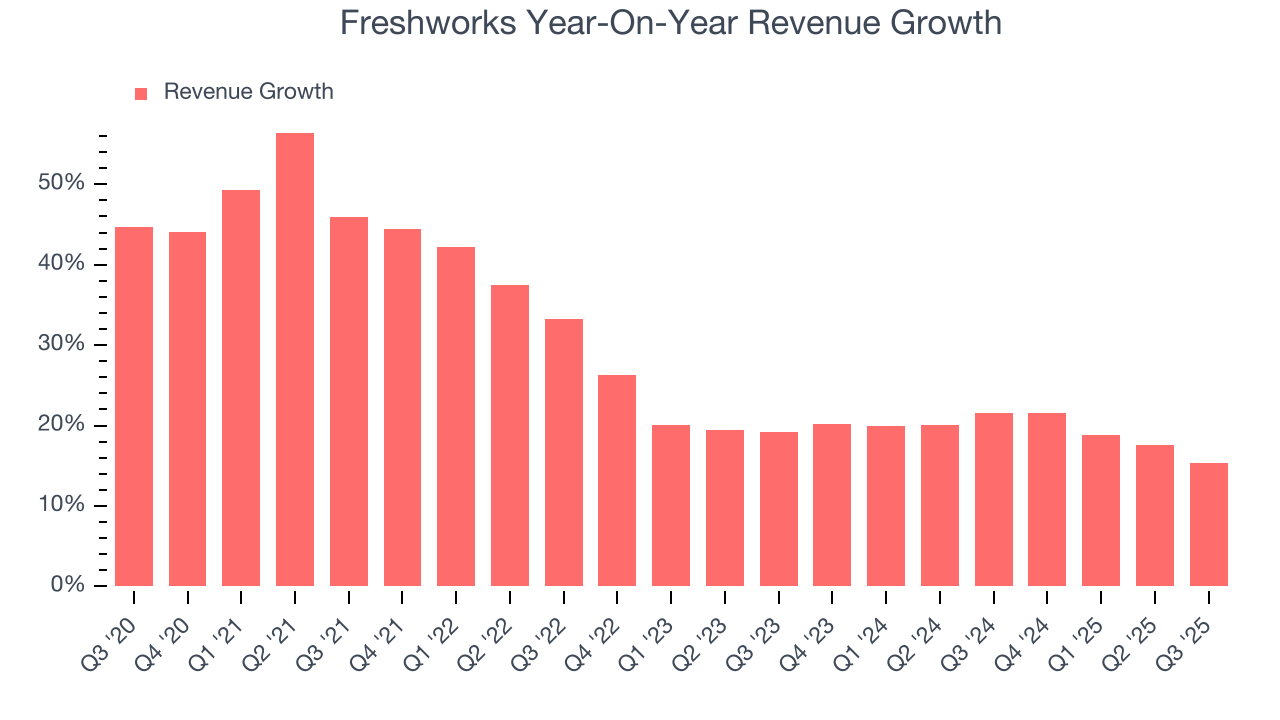
This quarter, Freshworks reported year-on-year revenue growth of 15.3%, and its $215.1 million of revenue exceeded Wall Street’s estimates by 3%. Company management is currently guiding for a 12.3% year-on-year increase in sales next quarter.
Looking further ahead, sell-side analysts expect revenue to grow 11.4% over the next 12 months, a deceleration versus the last two years. This projection is underwhelming and implies its products and services will face some demand challenges. At least the company is tracking well in other measures of financial health.
6. Billings
Billings is a non-GAAP metric that is often called “cash revenue” because it shows how much money the company has collected from customers in a certain period. This is different from revenue, which must be recognized in pieces over the length of a contract.
Freshworks’s billings punched in at $224 million in Q3, and over the last four quarters, its growth slightly outpaced the sector as it averaged 16.9% year-on-year increases. This performance aligned with its total sales growth and shows the company is successfully converting sales into cash. Its growth also enhances liquidity and provides a solid foundation for future investments. 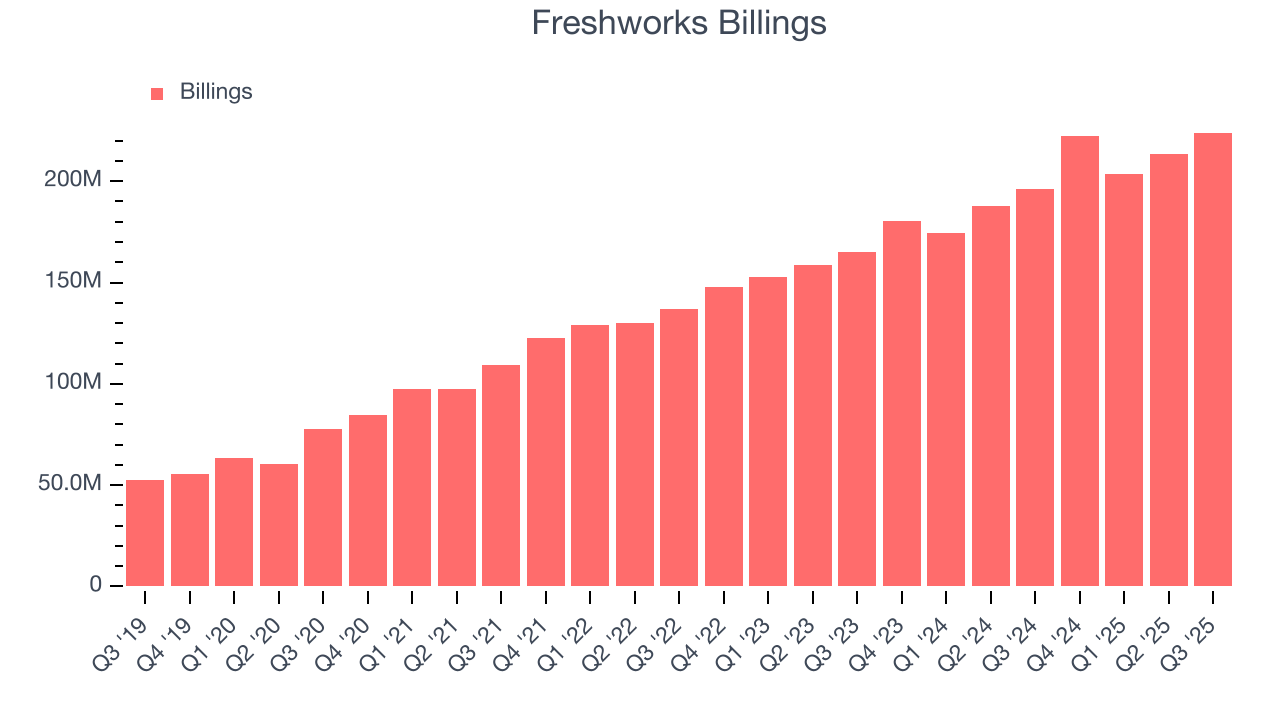
7. Enterprise Customer Base
This quarter, Freshworks reported 24,377 enterprise customers paying more than $5,000 annually, an increase of 402 from the previous quarter. That’s a bit fewer contract wins than last quarter and quite a bit below what we’ve observed over the previous year, suggesting its sales momentum with new enterprise customers is slowing. It also implies that Freshworks will likely need to upsell its existing large customers or move down market to maintain its top-line growth.
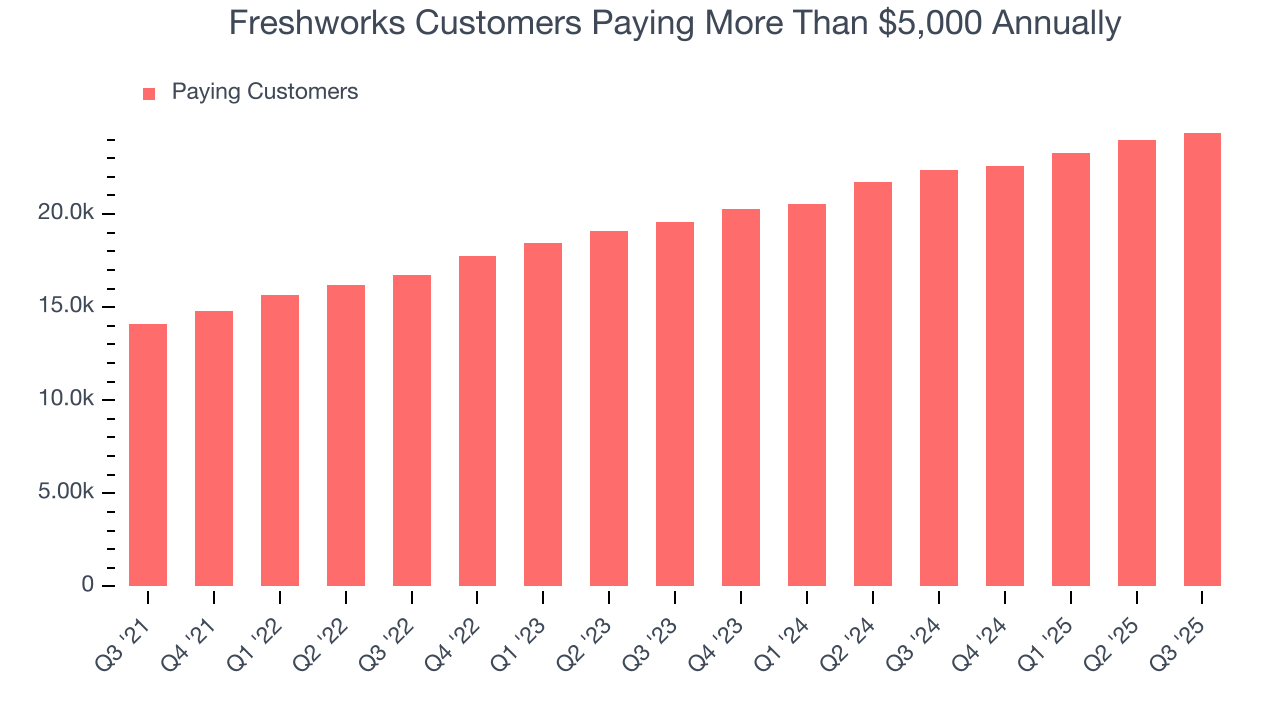
8. Customer Acquisition Efficiency
The customer acquisition cost (CAC) payback period represents the months required to recover the cost of acquiring a new customer. Essentially, it’s the break-even point for sales and marketing investments. A shorter CAC payback period is ideal, as it implies better returns on investment and business scalability.
It’s relatively expensive for Freshworks to acquire new customers as its CAC payback period checked in at 75.8 months this quarter. The company’s drawn-out sales cycles partly stem from its focus on enterprise clients who require some degree of customization, resulting in long onboarding periods. The complex integrations are a double-edged sword - while Freshworks may not see immediate returns from its sales and marketing investments, it is rewarded with higher switching costs and lifetime value if it can continue meeting its customer’s needs. 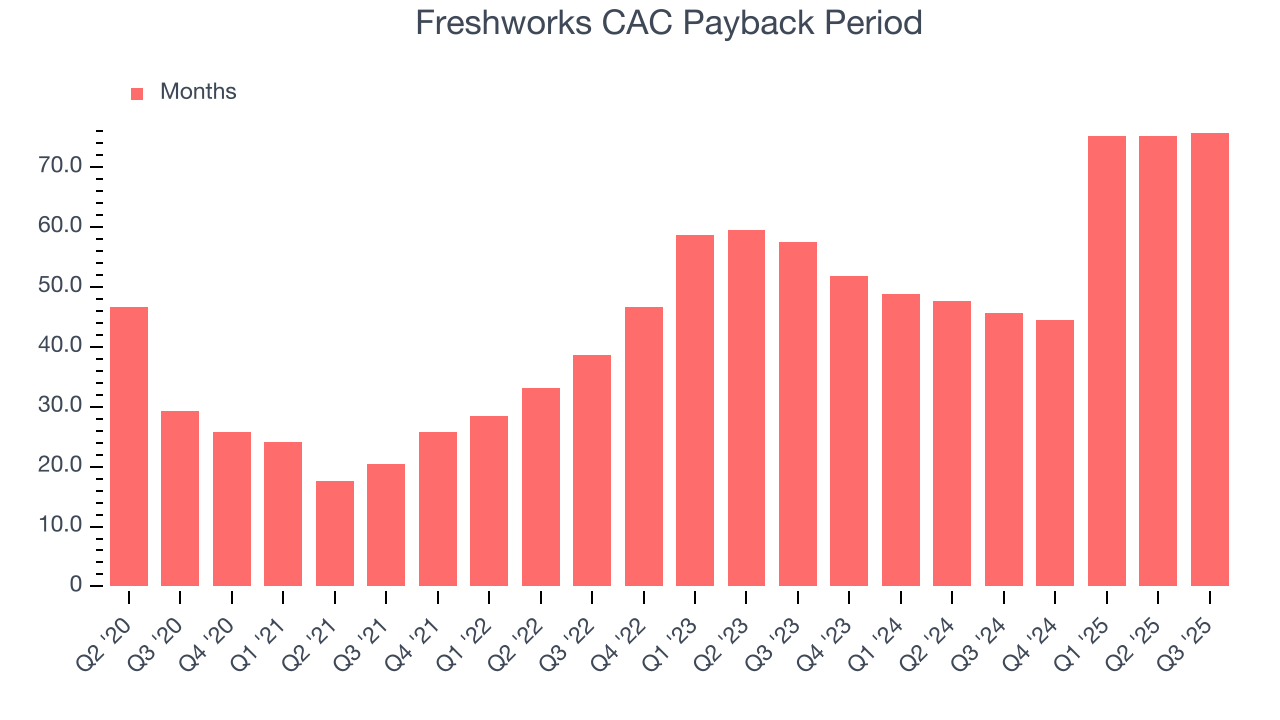
9. Customer Retention
One of the best parts about the software-as-a-service business model (and a reason why they trade at high valuation multiples) is that customers typically spend more on a company’s products and services over time.
Freshworks’s net revenue retention rate, a key performance metric measuring how much money existing customers from a year ago are spending today, was 105% in Q3. This means Freshworks would’ve grown its revenue by 4.8% even if it didn’t win any new customers over the last 12 months.
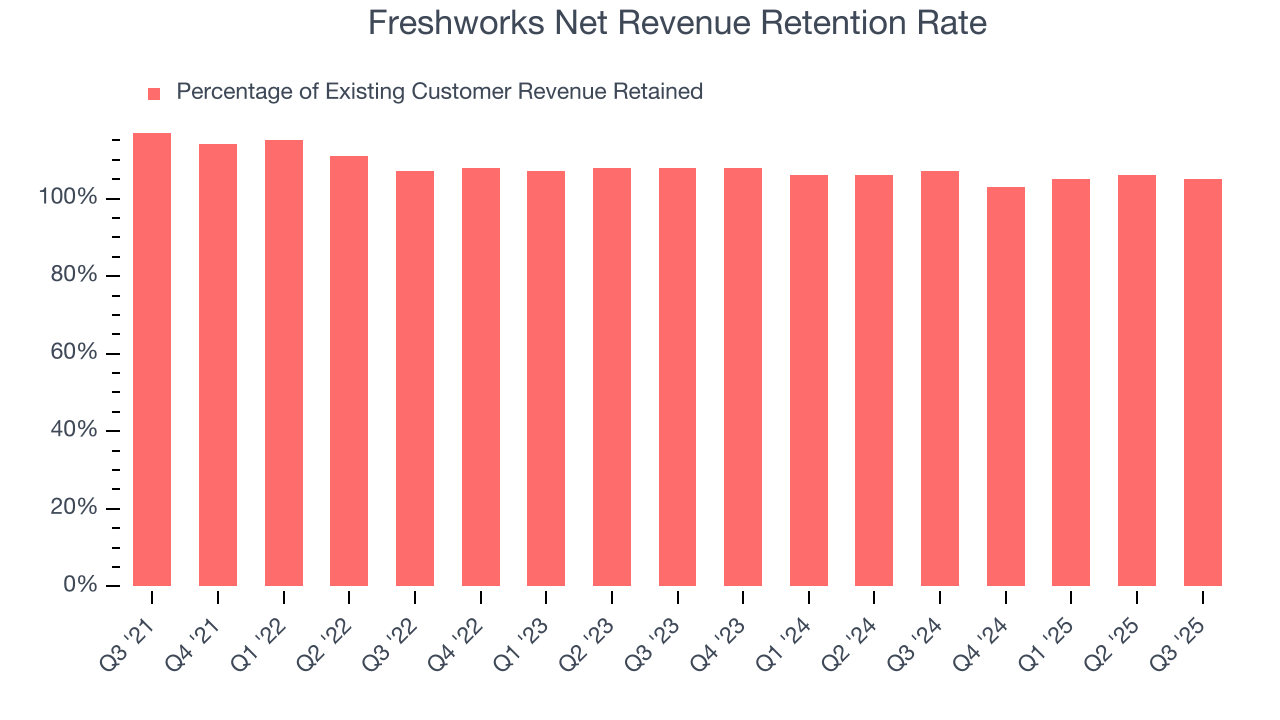
Freshworks has an adequate net retention rate, showing us that it generally keeps customers but lags behind the best SaaS businesses, which routinely post net retention rates of 120%+.
10. Gross Margin & Pricing Power
What makes the software-as-a-service model so attractive is that once the software is developed, it usually doesn’t cost much to provide it as an ongoing service. These minimal costs can include servers, licenses, and certain personnel.
Freshworks’s gross margin is one of the highest in the software sector, an output of its asset-lite business model and strong pricing power. It also enables the company to fund large investments in new products and sales during periods of rapid growth to achieve outsized profits at scale. As you can see below, it averaged an elite 84.8% gross margin over the last year. Said differently, roughly $84.77 was left to spend on selling, marketing, and R&D for every $100 in revenue.
The market not only cares about gross margin levels but also how they change over time because expansion creates firepower for profitability and free cash generation. Freshworks has seen gross margins improve by 2.6 percentage points over the last 2 year, which is very good in the software space.
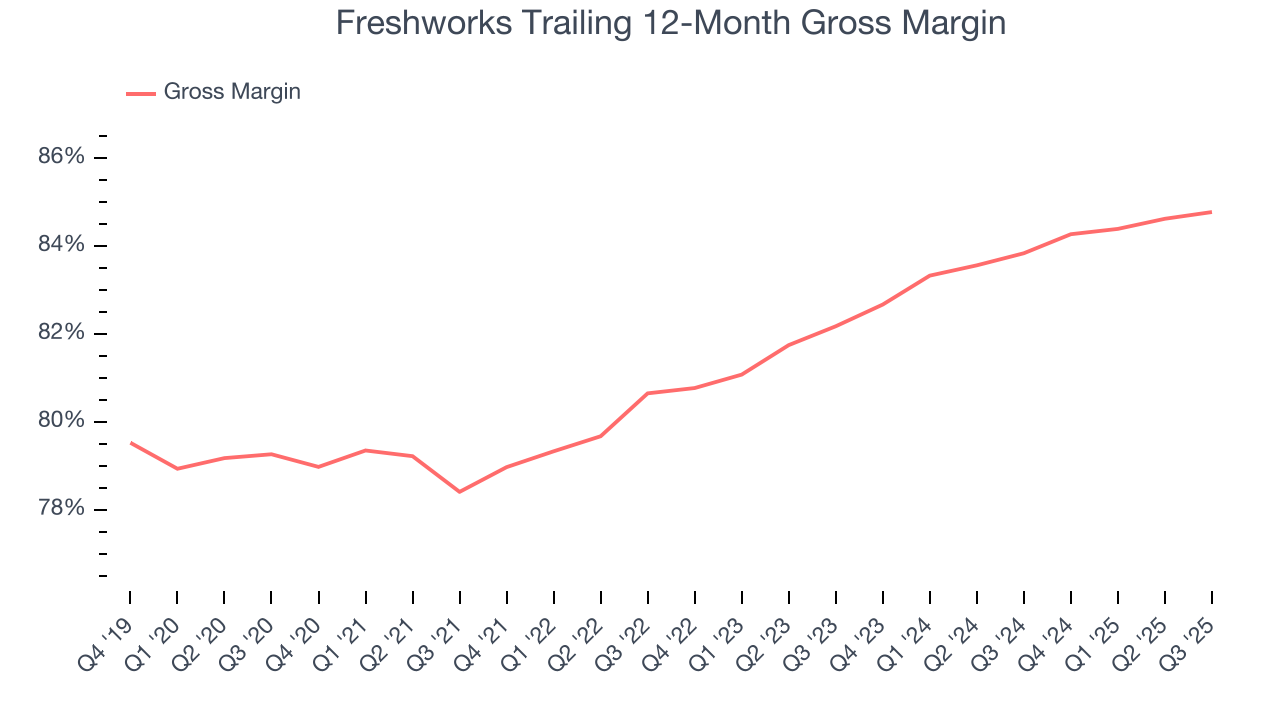
Freshworks produced a 84.7% gross profit margin in Q3, in line with the same quarter last year. Zooming out, the company’s full-year margin has remained steady over the past 12 months, suggesting its input costs have been stable and it isn’t under pressure to lower prices.
11. Operating Margin
Freshworks’s expensive cost structure has contributed to an average operating margin of negative 6.2% over the last year. This happened because the company spent loads of money to capture market share. As seen in its fast revenue growth, the aggressive strategy has paid off so far, but it’s unclear what would happen if Freshworks reeled back its investments. Still, we’re optimistic the business can continue growing and reach profitability upon scale.
Over the last two years, Freshworks’s expanding sales gave it operating leverage as its margin rose by 16.4 percentage points. Still, it will take much more for the company to reach long-term profitability.

In Q3, Freshworks generated a negative 3.5% operating margin.
12. Cash Is King
If you’ve followed StockStory for a while, you know we emphasize free cash flow. Why, you ask? We believe that in the end, cash is king, and you can’t use accounting profits to pay the bills.
Freshworks has shown robust cash profitability, driven by its attractive business model that enables it to reinvest or return capital to investors while maintaining a cash cushion. The company’s free cash flow margin averaged 25.7% over the last year, quite impressive for a software business. The divergence from its underwhelming operating margin stems from the add-back of non-cash charges like depreciation and stock-based compensation. GAAP operating profit expenses these line items, but free cash flow does not.
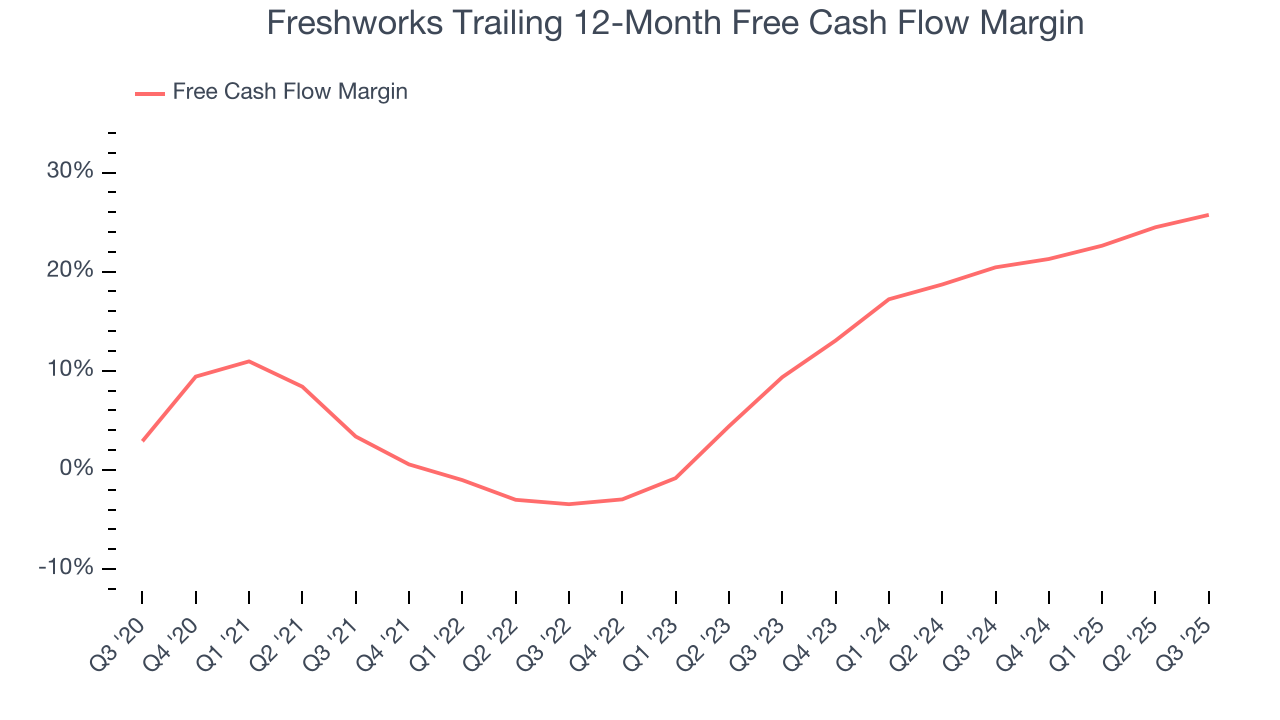
Freshworks’s free cash flow clocked in at $57.21 million in Q3, equivalent to a 26.6% margin. This result was good as its margin was 5.1 percentage points higher than in the same quarter last year. We hope the company can build on this trend.
Over the next year, analysts predict Freshworks’s cash conversion will fall. Their consensus estimates imply its free cash flow margin of 25.7% for the last 12 months will decrease to 26.4%.
13. Balance Sheet Assessment
Businesses that maintain a cash surplus face reduced bankruptcy risk.
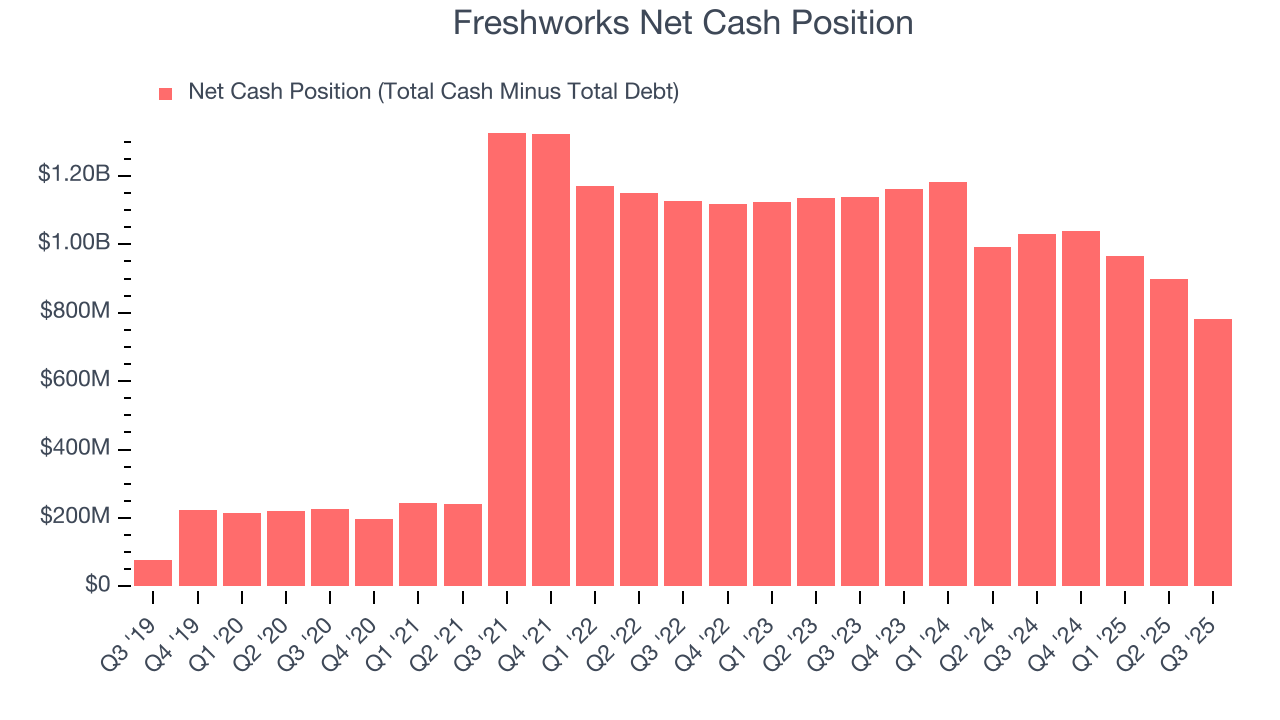
Freshworks is a well-capitalized company with $813.2 million of cash and $31.42 million of debt on its balance sheet. This $781.8 million net cash position is 25.6% of its market cap and gives it the freedom to borrow money, return capital to shareholders, or invest in growth initiatives. Leverage is not an issue here.
14. Key Takeaways from Freshworks’s Q3 Results
We were impressed by Freshworks’s optimistic EPS guidance for next quarter, which blew past analysts’ expectations. We were also glad its full-year EPS guidance trumped Wall Street’s estimates. On the other hand, its new large contract wins slowed. Overall, this print had some key positives. The stock traded up 4.2% to $11.54 immediately after reporting.
15. Is Now The Time To Buy Freshworks?
Updated: December 7, 2025 at 9:29 PM EST
We think that the latest earnings result is only one piece of the bigger puzzle. If you’re deciding whether to own Freshworks, you should also grasp the company’s longer-term business quality and valuation.
There are things to like about Freshworks. To kick things off, its revenue growth was strong over the last five years. And while its customers generally do not adopt its complementary products, its admirable gross margin indicates excellent unit economics. On top of that, its bountiful generation of free cash flow empowers it to invest in growth initiatives.
Freshworks’s price-to-sales ratio based on the next 12 months is 3.9x. When scanning the software space, Freshworks trades at a fair valuation. If you’re a fan of the business and management team, now is a good time to scoop up some shares.
Wall Street analysts have a consensus one-year price target of $18.43 on the company (compared to the current share price of $12.86), implying they see 43.3% upside in buying Freshworks in the short term.







